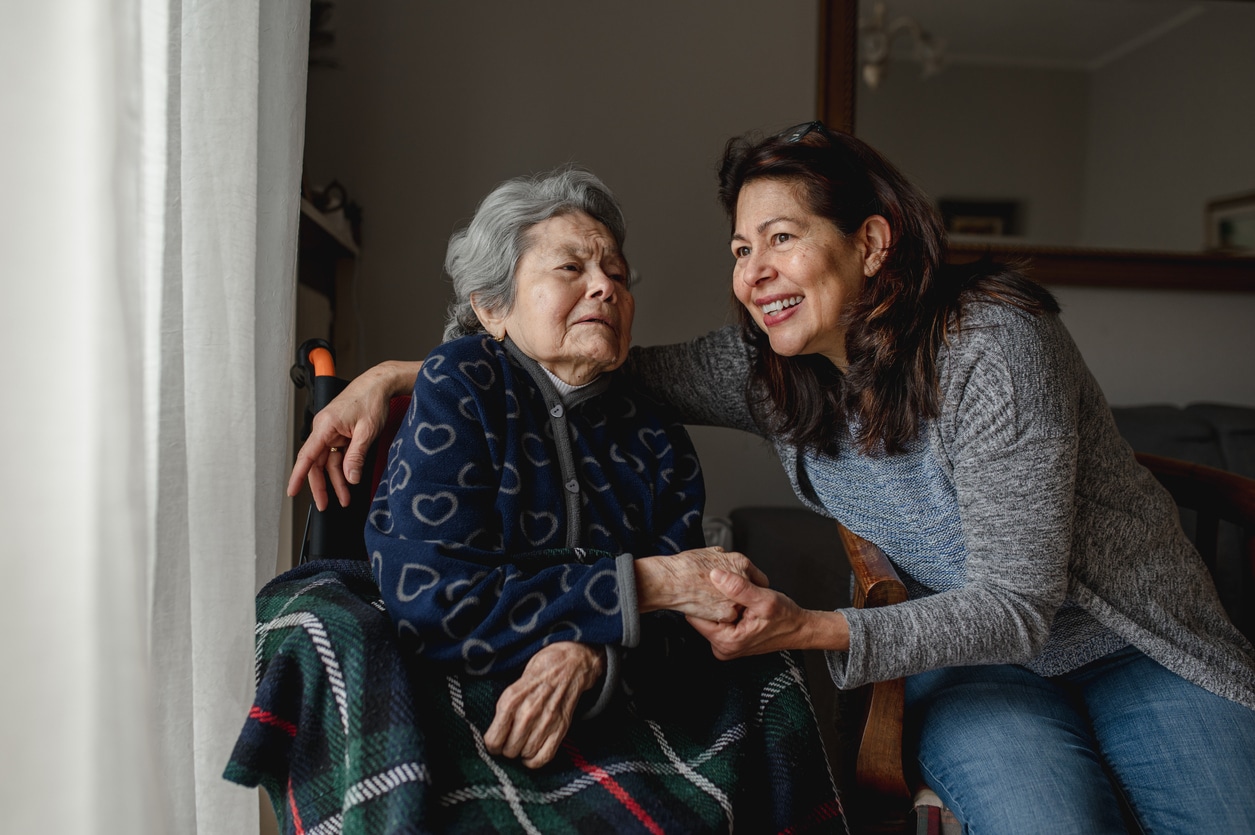Yoga is one of today’s most popular mind and body exercises. It has been shown to help improve respiratory and cardiovascular function. It can also relieve anxiety and depression, and ease pain and chronic stress. The benefits of yoga for seniors in particular include improved mobility, a reduced fear of falling, and enhanced quality of life.
Beginning Yoga for Seniors
Understanding the benefits of yoga is one thing. Beginning yoga for senior citizens can be a little more challenging. This is especially the case if there are mobility issues or disabilities to consider. However, the benefits are worth it.
“A lot of the time, seniors don’t have access to certain things that could help them maintain their quality of life,” says yoga teacher Molly Lehman, RYT 500. “Through yoga, they can feel empowered to take care of themselves and take their health into their own hands. Plus, this is a physical activity that requires some thought. Different parts of the brain get stimulated, which can bring them back to a happier place mentally.”
It’s important for healthcare professionals to learn about yoga for seniors and its benefits. When beginning yoga for seniors, you simply need to take a few steps first:
- Talk to healthcare professionals to understand if anything should be avoided. For example, those with glaucoma should avoid head-down poses.
- Ensure comfortable clothing and mats are available. If you’re starting with chair yoga, make sure a suitable chair is set up.
- Find qualified instructors who can help seniors learn yoga at a pace that suits them. Some senior centers and retirement homes may offer dedicated classes.
- Encourage yoga students to take things at their own pace. They can go slow, take plenty of breaks and modify certain poses if needed.
Chair Yoga for Seniors: Making Yoga Accessible to All
One of the most accessible forms of yoga for seniors is chair yoga. Instead of traditional yoga, seniors with limited mobility can practice chair yoga from a seated position.
“Seniors with limitations can still work their spine and gain flexibility in their hips from a chair,” says Lehman. “And if they can stand, there’s so much they can do standing behind the chair, holding onto it, such as modified warrior poses and even bending their knees and going up on their toes to strengthen their ankles.”
Chair yoga was also shown in one study to reduce seniors’ fear of falling. In addition, it can decrease their reliance on assistive devices for mobility. In fact, three of the 16 participants (who ranged in age from 68-97 years) were able to eliminate the use of assistive devices completely.
That said, there are some medical conditions for which yoga is not recommended. For instance, it may be dangerous for seniors with unregulated high blood pressure, advanced Parkinson’s disease or Alzheimer’s disease, or spinal degeneration to practice yoga. In addition, some medications may cause side effects such as dizziness or light-headedness. These can increase fall risk during a standing yoga practice.
These seniors should check with their physicians before beginning any exercise program. In many cases, they may be best suited to one-on-one sessions. A certified yoga teacher can give them individual attention and support.
Promoting Yoga as a Supplement to Medical Interventions
Yoga can offer extraordinary health benefits when it supplements traditional medical care. You may need to urge your senior patients to participate initially. Once introduced though, they often become receptive to the practice. Lehman says her senior students often need to be pushed to join in. That’s especially the case if they haven’t been exercising at all. But once they begin to practice, it has a tremendous impact on their lives.
Even for those seniors whose chronic conditions may be debilitating, Lehman says that yoga offers hope. “One of my senior clients had spinal stenosis, neuropathy, and arthritis in her knees, and her doctors told her she was going to be in a wheelchair in a matter of months,” Lehman recalls. “That was in 2004… she’s still walking. When it comes to our bodies, we can change our course of action and change the quality of our lives.”
The Benefits of Yoga for Seniors
Yoga has proven physical and mental health benefits. Unlike many other forms of exercise, it acknowledges the unity of mind, body, and spirit. It offers seniors a sense of spiritual connectedness and peace. This can be valuable at a time in their lives when they may be faced with declining health, chronic pain, the loss of loved ones, or other difficult transitions.
Yoga’s Effects on Emotions and Cognition
Several basic principles are at the core of the yogic philosophy of healing. These include a holistic approach to the different dimensions of the body and an individualized approach. The latter point is particularly important for seniors. Yoga also encourages students to be active in their healing and promotes positivity.
Several poses in particular are known mood boosters. These can positively impact the mental outlook of people of all ages, according to Lehman. “When we’re anxious, we round our shoulders and cave inward,” she explains. “When we open our chests in heart-opening poses such as bridge, we can get more breath, which makes us feel lighter.”
Classes that offer yoga for seniors can give older adults a positive and uplifting environment. It also gives them the opportunity to find community, notes Lehman. “The focus is on feeling good — not on sharing their complaints. So, it’s a light-hearted atmosphere where they’re enjoying each other’s company and getting to know other people they never would have met before.” Considering the benefits of socialization on life expectancy, these classes are one powerful way older adults can build social connections.
Research has also found that yoga can boost brain function and improve cognitive ability. Participants in a study conducted by researchers from the University of Illinois at Urbana-Champaign showed more improvement in cognitive performance after practicing yoga than after aerobic sessions or at baseline.
Another study was conducted by two of the same researchers. It found that practicing yoga three times a week for eight weeks boosted the cognitive ability of sedentary seniors. Compared to the control group, the senior yoga participants reported more accurate scores on tests of information recall, mental flexibility, and task-switching after a yoga class.
The Physical Health Benefits of Yoga for Seniors
The U.S. Centers for Disease Control and Prevention (CDC) reports that 80 percent of seniors have one chronic medical condition. Fifty percent have at least two. The CDC also states that regular physical activity is one of the most important steps to improve or maintain health. It cites yoga as one of the activities that helps seniors build muscle strength.
John Wilbert, MSPT is a physical therapist and director at Recovery Physical Therapy in New York City. He says that yoga can do more than just strengthen muscles. Many senior exercises promoted for healthy aging, such as balance training and flexibility exercises, are core components of yoga.
“As we age, we may have dehydration in our joints and muscles, and yoga can rehydrate them to help us maintain flexibility,” says Wilbert. “Lack of balance is also an age-related condition, and yoga uses a lot of tandem and single-stance poses that challenge us in multi-directional ways — the way that real life does — so that we learn to use our muscles to get back to balance if we fall off center.”
“Seniors are less likely to have fractures if they have balance,” Wilbert adds. A 2009 pilot study reveals that yoga can build bone density in seniors who have osteoporosis or osteopenia. These are two major fall risk factors in the older adult population. Yoga practitioners showed improvement in bone mineral density over a two-year period. In contrast, the control group experienced a slight loss.
Seniors can enjoy other health benefits of yoga, too, as shown by a Hospital for Special Surgery (HSS) study. Participants in multiple eight-week yoga classes offered at senior centers experienced decreased pain, improved mobility, and enhanced overall health. The HSS offered this program to promote the self-management of arthritis and other musculoskeletal conditions through exercise. At the end of the program, 48 percent fewer participants had pain on a daily basis. Additionally, 69 percent could climb several flights of stairs and 83 percent more could bend, kneel, or stoop.




